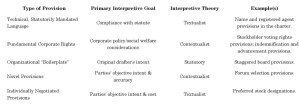Private ordering has become a common way to restructure key aspects of public corporation governance. Stockholder activists and boards of directors alike are testing the bounds of the freedom to contract in the charter and bylaws, adopting provisions aimed at reshaping the balance of power in corporations. In considering recent efforts, the courts have largely shown a willingness to uphold these governance arrangements. With no sign that courts will restrict corporate governance contracting[1] and every indication that the private ordering trend will persist, the focus of legal battles will shift from the validity of contract provisions to their meaning. Interpretation will play a central role in the adjudication of charter and bylaw provisions as the courts are asked to distinguish between the variations that result from creative lawyering. The interpretation of organizational documents will thus play a significant role in shaping corporate law and norms.
Contract interpretation generally, and charter and bylaw interpretation specifically, are, however, topics to which scholars have devoted limited attention. Relying on the contract metaphor that has pervaded corporate theory since the early 19th century, courts import traditional contract principles to resolve questions of interpretation involving a charter and bylaws. Yet, a corporation’s organizational documents and contracts are not mirror images. The assumptions and policies underlying contract formation are largely absent from charter and bylaw adoption and amendment, making contract principles a poor method of interpretation. Corporate charters and bylaws lack traditional contract formation elements such as mutual assent. As Professor Ann Lipton points out in her work, stockholders can be more accurately described as “wards,” rather than as counterparties negotiating and consenting to the terms of organizational documents.[2] Further, organizational documents serve both a private and public law function, triggering social welfare considerations in a way that contracts do not. While traditional contract interpretation principles are based on a system of parties privately creating and structuring their relationship, charters and bylaws exists within state corporate law regimes. Charter and bylaw provisions must thus be interpreted in accordance with state-imposed principles and duties and not specific parties’ intentions at the time of formation.[3] These unique features make organizational documents distinctive contract-like institutions that trigger their own distinctive interpretation concerns and goals.
In Interpreting Organizational “Contracts” and the Private Ordering of Public Company Governance, I propose a tailored interpretive framework for corporate organizational documents. Charters and bylaws are not uniform across corporations or even within an individual document. Rather, these documents are a rich combination of standardization, customization, and innovation. The proposed framework below takes into account the diverse aspects of a charter and bylaws and the interpretation considerations they evoke. The framework provides for a two-step approach to resolving interpretation disputes. Examining the makeup of a public corporation’s charter and bylaws, the framework first requires courts to place the provision at issue in one of five categories: (1) technical, statutorily mandated language, (2) fundamental corporate rights, (3) organizational “boilerplate,” (4) novel provisions, or (5) individually negotiated provisions. Each of these categories elicits different policy concerns and interpretive goals. Thus, the second step in the framework links an appropriate interpretation theory and its principles – textual, contextual, or statutory—to each category. A summary of this analysis is set forth below:[4]
The framework provides both flexibility and predictability. First, it allows for case-by-case analysis and judicial discretion, both of which are integral to corporate law. Categorization of provisions that implicate more than one category will require the courts to assess the particular terms of the provision at issue as well as competing interpretation considerations before choosing the proper classification. Further, categorization is not permanently fixed for all time. A novel provision may, for example, become so widely-adopted that in the court’s opinion it becomes organizational boilerplate, thereby shifting the interpretation analysis. Currently, the contract metaphor masks the nuances in judicial interpretive rulings. By engaging in a more explicit and tailored analysis, however, courts make clear the broader interpretive scheme for organizational documents and are obliged to explain why they are departing from that scheme. The result is clearer guidance to corporate management, investors, attorneys, regulators, banks, and capital markets, among others, all of whom are sensitive to judicial enforcement, interpretation, and general commentary on corporate governance practices.
ENDNOTES
[1] One exception to this would be Sciabacucchi v. Salzberg, where the court ruled that corporate governance contracting must relate to the internal affairs of the corporation, and thus invalidated a federal forum charter provision. C.A. No. 2017-0931-JTL, slip op. at 2-5 (Del. Ch. Dec. 19, 2018).
[2] Ann M. Lipton, Manufactured Consent: The Problem of Arbitration Clauses in Corporate Charters and Bylaws, 104 Geo. L.J. 583, 605-611 (2016).
[3] As the Delaware Court of Chancery emphasized in Sciabacucchi v. Salzberg, “The certificate of incorporation differs from an ordinary contract, in which private parties execute a private agreement in their personal capacities to allocate their rights and obligations. When accepted by the Delaware secretary of state, the filing of a certificate of incorporation effectuates the sovereign act of creating a “body corporate” – a legally separate entity. The State of Delaware is an ever-present party to the resulting corporate contract, and the terms of the corporate contract incorporate the provisions of the DGCL.” C.A. No. 2017-0931-JTL, slip op. at 3 (Del. Ch. Dec. 19, 2018); see also Lipton, supra note 2, at 612 (“In the corporate context, however, courts do not evaluate whether managers behaved in accordance with shareholders’ intentions, but rather whether they behaved in accordance with state-imposed duties of conduct.”).
[4] 60 Wm. & Mary L. Rev. 985, 1041, Table 1. (2019).
This post comes to us from Professor Megan W. Shaner at the University of Oklahoma College of Law. It is based on her recent article, “Interpreting Organizational ‘Contracts’ and the Private Ordering of Public Company Governance,” available here.
 Sky Blog
Sky Blog

